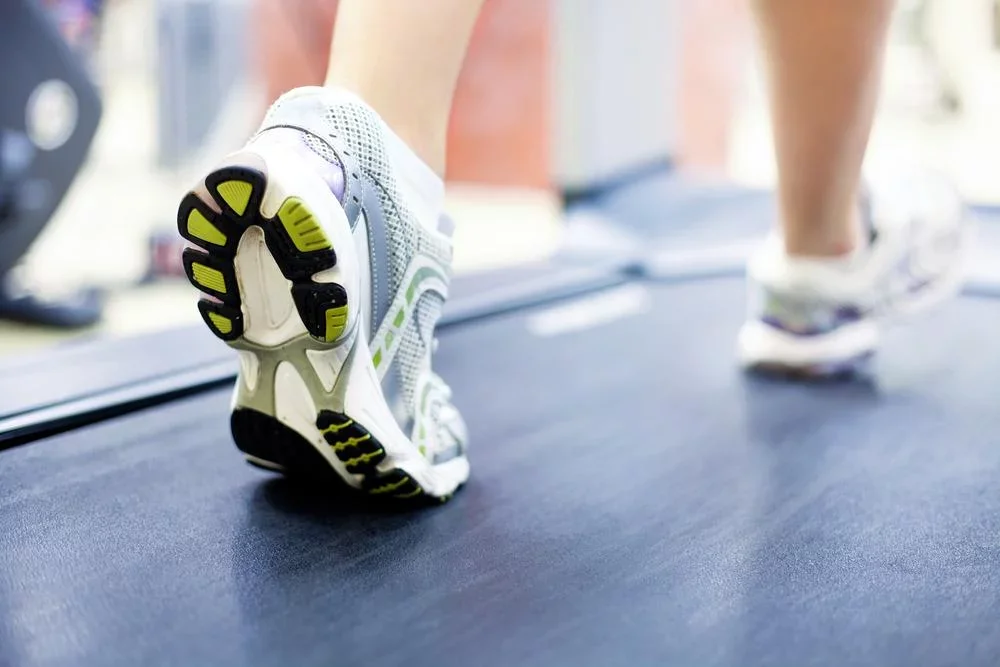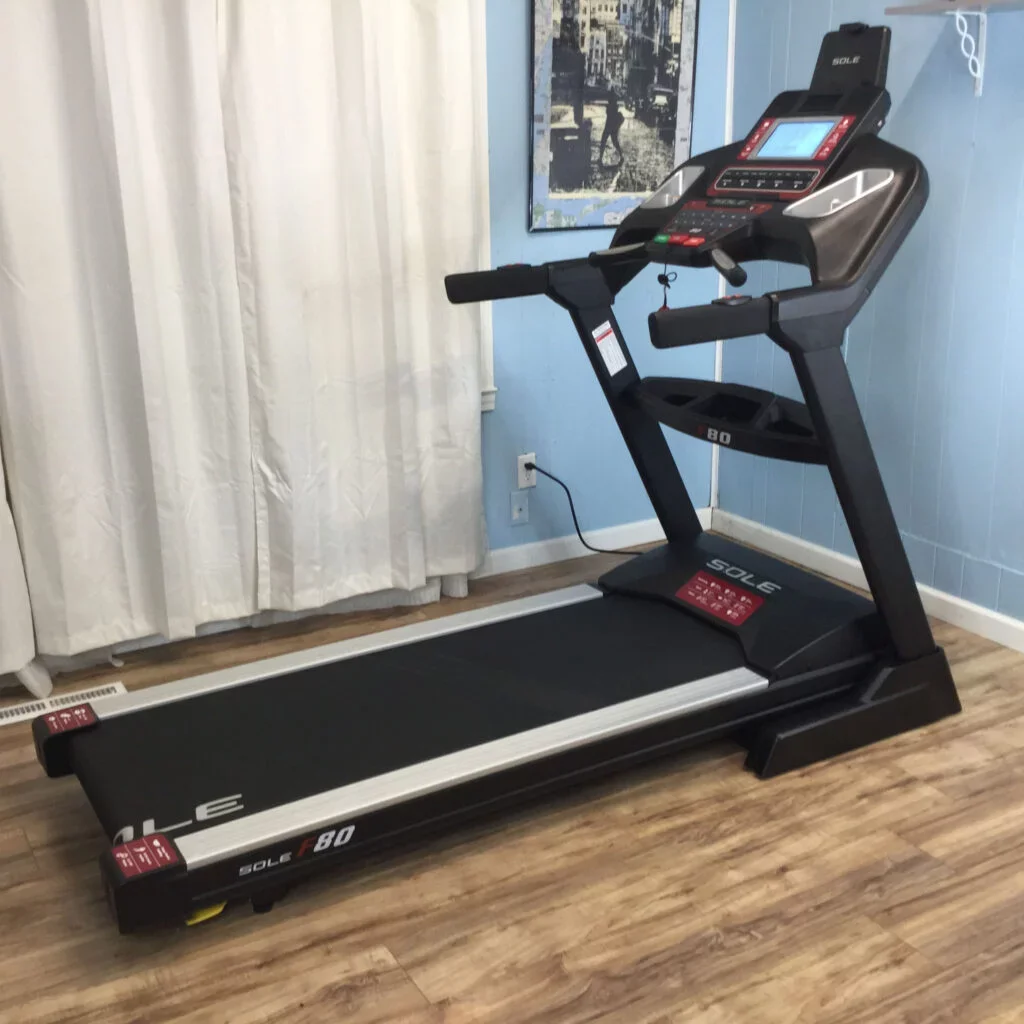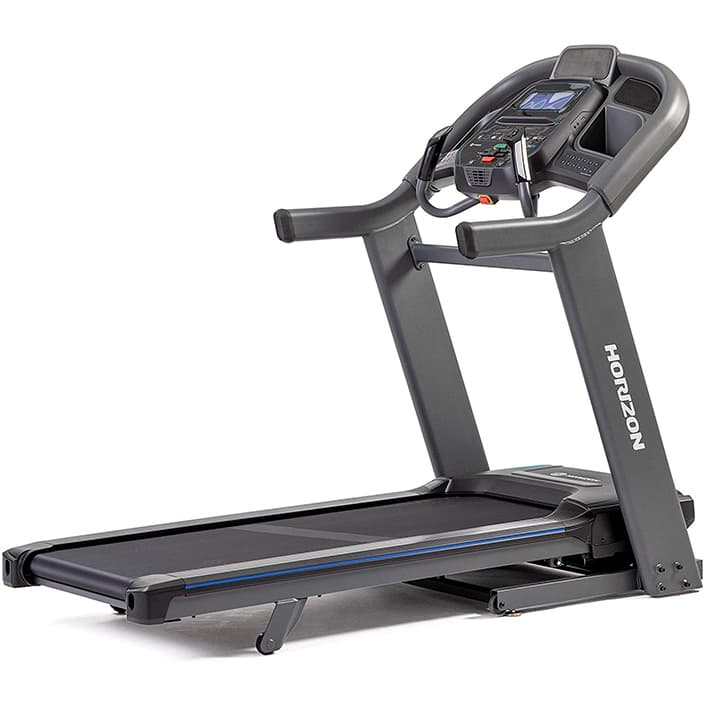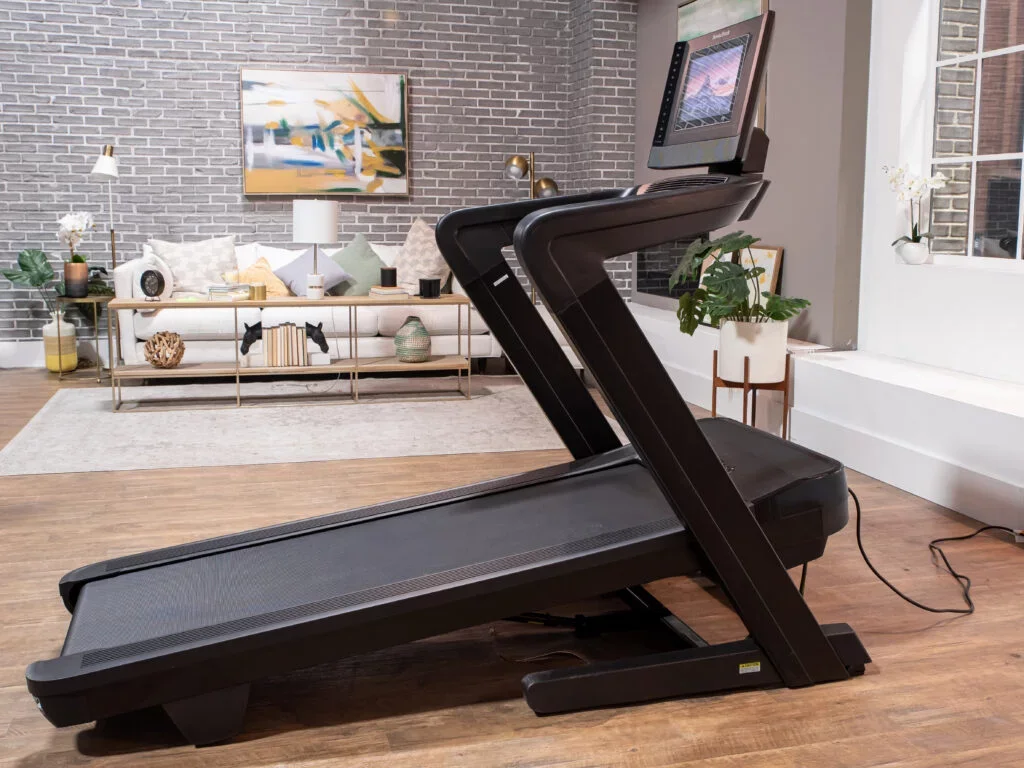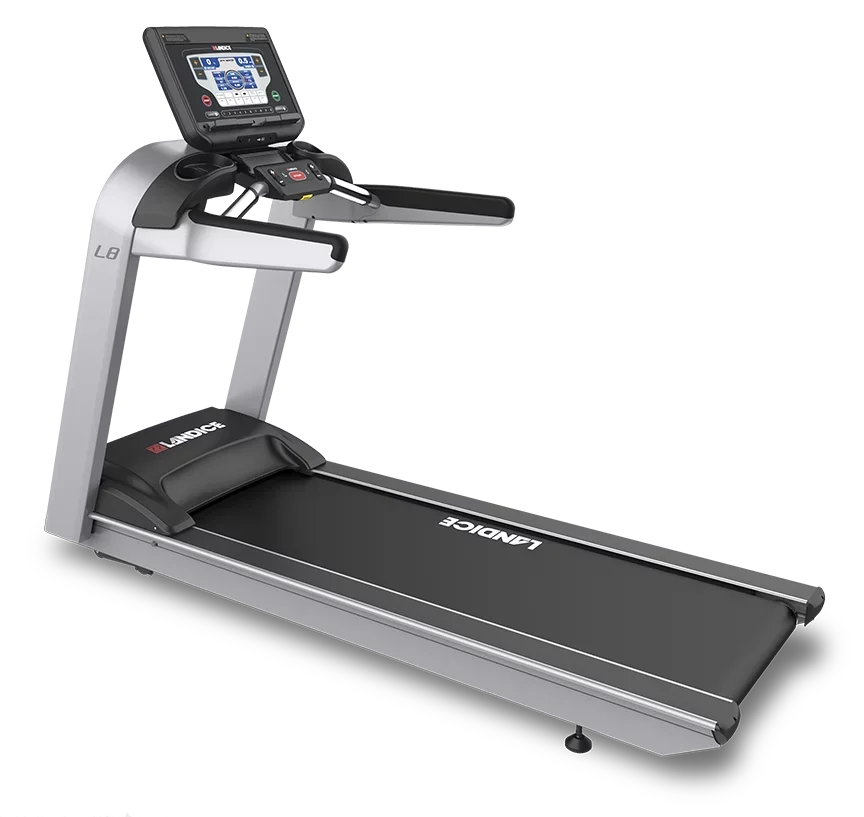Best Treadmill for Heavy People
It’s a great irony indeed that treadmills rank among the best exercise machines around for weight loss, and yet so many sport a maximum user weight of 250 pounds. In my experience, definitions vary widely, and the fact is one doesn’t have to be clinically obese per se to qualify as heavy. As a bodybuilder myself, I’m used to being a little heavier than some might expect given my 5’10” frame. Users taller than 6’4″ typically need to consider the tread belt length when buying a machine, as do those with longer running strides in general. These larger built folks may also double as heavier people. The same is true for powerlifters, football players, and perhaps some patients suffering from type 2 diabetes. But fear not. There are plenty of great, well-built treadmills with the motor size and frame sufficient to handle folks even up to 500 pounds. We just need to check the weight limit and a few other factors.
Tired of having to thumb past great models in search of maximum user weight? Don’t sweat it. We’ve rounded up the top five treadmills for heavy people and home use, which could be anyone up to 500 pounds. And some of these even qualify as a folding treadmill. For my money, folding treadmills are a great buy when available given the ease of maintenance and movement. Buyers won’t have to sacrifice anything in terms of bells and whistles, and frankly these units are priced right. If you’re looking to do a little research before the purchase, check out our review below. Also, we have more information yet here in terms of what to look for when shopping for a new home treadmill.
Why You Should Trust Our Review Of These Treadmills
At TreadmillReviews.net, we bring you comprehensive reviews of treadmills so you can decide which one is right for you. Our staff thoroughly test all the treadmills we review. We install them, walk on them, run on them, and try out all of the features. We get to know each and every treadmill we review extremely well. Our reviewers log miles on the deck. We listen and record the sound of the motor, we test and measure the incline/decline, try out all aspects of the console and try the treadmill’s features, such as apps.
Every treadmill we review undergoes the same rigorous process. That way we can compare and contrast them and give you an honest review of what we think. Many of these particular treadmills has been around for many years, and we’ve done previous reviews.
Our reviewers are treadmill and fitness experts. Brian, the author of this review, is a competitive bodybuilder for the last 11 years, and is a 7-time national qualifier in both men’s bodybuilding and classic physique within the NPC competitions. He has coached and been coached on cardiovascular training, HIIT, and nutrition, particularly as it pertains to weight loss for competitions. He is an expert at treadmills, has been on this treadmill, and has been exercising on treadmills since his days as a high school and college athlete. Y ou can trust his opinion on all of the treadmills he reviews.
Top by Category
Best Treadmill for Streaming Classes – Horizon 7.4 AT
Best Runner-Up Treadmill for Heavy People – NordicTrack 1750
Best Treadmill for the Heaviest Walkers – Landice L8
Best Treadmill for Heavy Incline Training – Life Fitness Club Series
1. Best Overall Treadmill for Heavy People – Sole F80
Check Price on Amazon Check Price on Dick’s Sporting Goods
Treadmill shoppers are no stranger to the Sole F80, which is one of my favorites to review and use. I’ve noticed over the years it’s consistently ranked a top buy across many categories. This is good news for heavier users who want a treadmill their friends and family can enjoy as well. Sporting a weight limit of 350 pounds, this machine also brings a rock-solid warranty and reputation for service. And believe it or not, it’s a folding treadmill. Another big plus is the Cushion Flex Whisper Deck which reduces joint impact by 40%. The Sole F80 actually made the top spot on our list for best overall home treadmill many years running now.
Some of the Sole F80’s stellar highlights which make it good for folks in the 300 to 350-pound zone include: a roomy 22″ by 60″ running deck suitable for all the family; a commercial-standard 3.5 CHP motor which can support running as well as walking; and a power incline up to 15% to sculpt your lower body. It also features 2.36″ rollers. When considering the 350-pound user weight, you need to keep the roller and motor size in mind as I’ll explain below. But anyone in the 350-pound zone would definitely want rollers over 2″ in diameter, as they’re the cylinders which stabilize and pull the belt. You also need a motor of 3.5 CHP to pull the weight. When fully assembled, this treadmill itself weighs 274 pounds, which is great indicator of stability when handling heavier users. For entertainment and workout stats tracking you will have a 10.1″ touchscreen display with 10 preset programs, and 12 if you count the custom programs, so you can diversify your training. True, this isn’t among the larger screens out there, which is why the unit also has a built-in tablet holder to dock your device and Bluetooth connectivity for audio and stats tracking. Like to monitor your fitness progress? You can track your stats through the free Sole Fitness app and sync this workout data to your favorite fitness app like Fitbit, Record, or Apple Health. The F80 caters to a range of fitness abilities and types of training, so it’s a solid option to bring home for all the family to enjoy. As I’ve written before, the big benefit to the Sole family of machines is they offer built-in programs so you don’t necessarily need a paid app. See our detailed review of the Sole F80.
| Pros | Cons |
|---|---|
|
|
Key Specs
| Motor | 3.5 HP |
|---|---|
| Incline | 0 — 15% |
| Running Area | 22″ x 60″ |
| Folding | Yes |
| Top Speed | 12 MPH |
| Weight Capacity | 350 LBS |
| Dimensions | 82.5″ L x 38″ W x 66″ H |
| Screen | 10.1″ Touchscreen |
| Warranty | Lifetime Frame, Motor, Deck; 3 Years Electronics & Parts; 1 Years Labor |
2. Best Treadmill for Streaming Classes – Horizon 7.4 AT
Proving that a bigger treadmill doesn’t necessarily mean a bigger price, the Horizon 7.4 AT comes in online at budget friendly prices, chock full of great features. One of the things I love about the Horizon lineup of machines is their compatibility with so many different apps, as well as built-in programs. With a maximum user weight of 375 pounds, the machine sports 3-Zone Variable Response Cushioning which customizes the shock absorption to the front, middle, and the end of the belt to fit the individual runner. This is a great feature for people with obesity, or taller runners, whose stride is different than the average user. The Horizon 7.4 AT runs off a 3.5 CHP motor with a .08-inch thick deck, and .063-inch belt, all atop 2.36-inch/1.811-inch tapered rollers. Heavy people using a treadmill need that kind of support for sustained training as the overall load placed on the machine dictates a good deal of its life. Another big plus for the Horizon 7.4 AT is its outstanding lifetime warranty on the frame and motor. In my experience, Horizon does an excellent job manufacturing its motors and you shouldn’t have a problem there. This is a key factor if you’re a potential user whose weight is between 200 and 375 pounds. One of the big benefits to this model for 375-pound folks is the 2.36″ rollers and 3.5 CHP motor, as opposed to other units with rollers under 2″ and motors under 3.0 CHP. Rollers are the metal cylinders placed at either end of the tread deck that pull the belt. If you’re near 375 pounds, you’ll definitely want the heavier grade of rollers to keep that belt moving and not burn out the motor.
And there’s no fear that lower price means lower options here. This treadmill offers an unlimited number of interactive training options. This is great for families with different members hopping onto the machine tuning into different interactive training apps. Other treadmills we’ve reviewed are often tucked into one app or another, while this one allows great variety. One downside is this is what we refer to as a bring-your-own-tech treadmill. Built with a 8.25-inch LCD screen, it features a free phone/tablet app that allows users to connect their own devices to it, as many folks these days want bigger screens. So most people will be bringing their own devices as opposed to relying on the smaller LCD. This is actually a good call on Horizon’s part when it comes to value and versatility. Not only does it keep the cost down as people use your own screen, but it also allows users to tune into any fitness app including Peloton using their own device. That makes for a great addition to the home gym. As I’ve written before, folks either want built-in high-definition screens, or they prefer to bring their own tablet. If you’re in the latter group, this might be a pick for you.
As well as unlimited interactive streaming options (which Horizon offers discounts on), other highlights include: an easy-to-fold-frame; powerful 3.5 CHP motor which can keep pace with interval training; a roomy 60″ by 22″ track; Bluetooth heart-rate monitoring; and preset programs including Sprint 8 training program, a HIIT training program for runners. You get a lot of bang for your buck with the Horizon 7.4 AT, especially if you and the rest of your household members want to try a variety of interactive training apps. See our detailed review of the Horizon 7.4 AT.
| Pros | Cons |
|---|---|
|
|
Key Specs
| Motor | 3.5 CHP |
|---|---|
| Incline | 0 – 15% |
| Running Area | 22″ x 60″ |
| Folding | Yes |
| Top Speed | 12 MPH |
| Weight Capacity | 375 LBS |
| Dimensions | 76″ x 37″ x 64″ |
| Screen | 16 Digit Alphanumeric LED & 8.25″ LCD Screen |
| Warranty | Lifetime Frame & Motor; 5 Years Parts; 2 Years Labor. |
3. Best Runner-Up Treadmill for Heavy People – NordicTrack Commercial 1750
Check Price on Dick’s Sporting Goods
If streaming training classes is a consideration for weight loss, treadmill fans will love the NordicTrack Commercial 1750. No doubt one of my all-time favorite weight-loss tools, I cut from 221 pounds to 165 pounds in five months using a NordicTrack Commercial 1750 and the iFit program so as to compete in a bodybuilding show. With a whopping 400-pound weight max, this treadmill is iFit-enabled, meaning trainers can control the machine’s incline and decline from remote locations. This came in handy when I incorporated weighted vest training into my hiking programs. And yes, it’s foldable. If unfamiliar with the iFit program and how it works, feel free to read our detailed review right here. One of the better treadmill apps on the market for those looking to lose weight, the NordicTrack family has been partnering with this program for a number of years with many of its machines.
More key features include a smooth and quiet 3.5 CHP motor which powers a 12% incline and 3% decline to tone your lower body. It also features 2.5″ rollers and a 2-ply belt. Again, for heavy users near the 400-pound mark, that larger motor is a key point as they won’t have to worry about slowing down the motor over time. If you’re in the 300 to 400 pound zone, you’ll also want to make sure the rollers on your unit are over 2″ in diameter and you have a 2-ply belt. Also, treadmills which offer both incline and decline offer a unique approach to weight loss. This unit also sports a 14-inch, tilt and pivot, HD iFit-enabled touchscreen with a free 30-day iFit membership included for interactive training and stats tracking. If entertainment is needed to keep you moving on the workout, it has built-in speakers and Bluetooth audio for you to listen to all your favorite workout playlists. The Bluetooth feature can also be used in conjunct with heart rate monitors.
For those who’ve passed over this unit in years past, improved 2024 features include solid handrails and OneTouch Controls, a Quiet Drive Inline Technology which keeps the unit, another key point for those with families or roommates. This treadmill works for both walking or long-distance running, and it’s built to include High Intensity Interval Training into the routine. For heavier people seeking a high-quality treadmill for all the family to enjoy, the NordicTrack Commercial 1750 makes for an excellent buy. See our in-depth review of the NordicTrack Commercial 1750.
| Pros | Cons |
|---|---|
|
|
Key Specs
| Motor | 3.5 CHP |
|---|---|
| Incline | -3 — 12% |
| Running Area | 22″ x 60″ |
| Folding | Yes |
| Top Speed | 12 MPH |
| Weight Capacity | 400 LBS |
| Dimensions | 80″ L x 38″ W x 65″ H |
| Screen | 14″ Smart HD Touchscreen |
| Warranty | 10-Year Frame, 2-Year Parts, 1-Year Labor |
4. Best for the Heaviest Walkers – Landice L8
With a maximum user weight of 500 pounds, the Landice L8 certainly takes it to the limits. This treadmill has always reminded me of the song “Mr. Bombatic.” It’s certainly a heavy-duty treadmill. While probably more than needed for most people overweight, this unit is a perfect match for those with severe weight-related limitations who will be walking their way to health. As one would expect, this treadmill has a powerful motor at 4.0 CHP which again is an important consideration for heavier folks. Plenty of horsepower. The frame itself is also considerably larger than its rivals at 83 inches x 35 inches x 61 inches, with a 22-inch x 63-inch running surface, which you’ll definitely need if you’re in the 500-pound zone given that the longer track better distributes that weight across more surface area.
The biggest downside for most people right off the bat is price. In the $5,899 club, the machine is certainly pricier than alternatives. I’d recommend checking with your physician or health insurance provider to see if you might qualify for assistance. But for folks between 400 and 500 pounds looking for a walking treadmill to lose weight, this might be the best option for home fitness. And the buyer is getting quality here. With incline levels up to 15%, the L8 sports 1,000-pound thrust elevation style motor. The reversible deck is a full 1 inch thick and rides atop 3.5-inch diameter, 22-pound steel rollers, as opposed to smaller models sub-2″ rollers, some of which are made of aluminum. The L8 also comes with wireless heart rate monitoring and a lifetime warranty for the frame and motor. So right off the bat, the answer to the question of why this treadmill is best for the heaviest of folks comes down to the quality of the parts. I see 22-pound, 3.5″ steel rollers and immediately know this machine won’t struggle with the weight of a 500-pound man. I also see a full 1″ thick reversible deck as the reason the company can guarantee the frame for life, not to mention the 4.0 CHP motor with 1,000 pound thrust capacity. If you’re in the 500-pound club, you’ll certainly need 1,000 pounds of thrust capacity given the duration of the workouts.
Screen-wise, the treadmill comes with three different options for consoles: The Pro Sports Control Panel, Cardio Control Panel, and the Achieve. The machine also comes with a tablet bracket so users can bring their own device for personalized streaming. See our detailed review of the Landice L8.
| Pros | Cons |
|---|---|
|
|
Key Specs
| Motor | 4.0 CHP |
|---|---|
| Incline | 0 — 15% |
| Running Area | 22″ X 63″ |
| Folding | No |
| Top Speed | 12 MPH |
| Weight Capacity | 500 LBS |
| Dimensions | 83″ L x 35″ W x 61″ H |
| Screen | Depends on Console |
| Warranty | Lifetime Frame, Motor and Parts; 5 Years on Console |
5. Best Home Treadmill for Incline Training – Life Fitness Club Series+
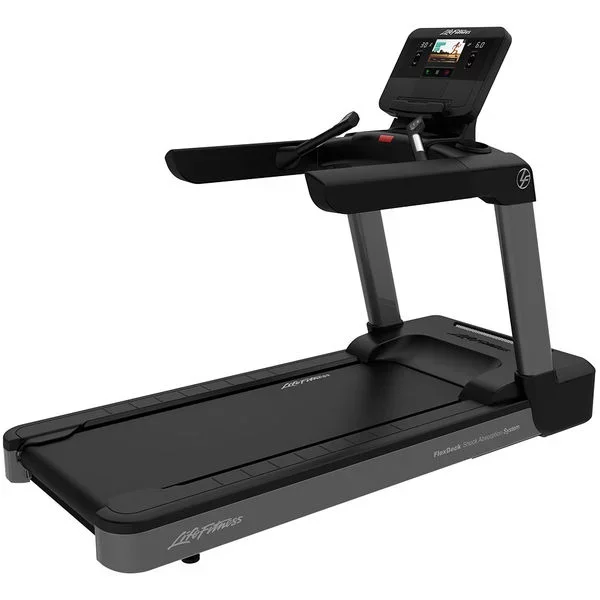
Measuring 82 inches x 36 inches x 56 inches, the treadmill belt features a 22-inch x 60-inch running surface and 3.5″ steel rollers. With a 4.0 CHP motor, the machine can reach top speeds of 12 mph. That’s great horsepower for larger users between 300 and 400 pounds. Again, as with the other treadmills here, I see the 3.5″ steel rollers and 4.0 CHP motor as the primary keys to higher weight maxes. This treadmill comes options for the console and handrails, with the SE3 featuring a large 21.5-inch 1080p touchscreen, the ST a 21.5-inch touchscreen, and the X console a 7-inch touchscreen, and the C console an LED screen. Built atop 3.5-inch steel rollers, other features include Bluetooth and easy access controls. This model also happens to come with one of the broadest selection of entertainment options, workout programs, and apps, including Lifescape and RunSocial, as well as ESPN, Newsy, YouTube, and Netflix. See our detailed review of the Life Fitness Club Series+.
| Pros | Cons |
|---|---|
|
|
Key Specs
| Motor | 4.0 CHP |
|---|---|
| Incline | 15% |
| Running Area | 22” x 60” |
| Folding | No |
| Top Speed | 12 MPH |
| Weight Capacity | 400 LBS |
| Dimensions | 82” L x 36” W x 56” H |
| Screen | Depends on Console |
| Warranty | Lifetime on Frame/Motor, 10 Years Electrical/Mechanical, and 1 year Labor |
To fully contrast these models, check out our comparison tool. When using, check off any treadmill involved and look at in more detail and then click ‘compare’. Learn more about what to look for when shopping for a new treadmill specifically for heavy people below.
Treadmills for Heavy People: Key Points to Consider
What Does it Mean to be Heavy?
It’s a valid question and one I’d leave to the individual’s discretion. But for beginners, the user weight maximum afforded by each machine should serve as a general guide. Treadmills, exercise bikes, and even rowers, all come with maximum user weights, and in some cases, I’ve found them to be quite ironic in that they’re clearly designed for people who don’t weigh over 250 pounds. But whether trying to lose a few inches around the belly for summer, or under a physician’s directive to shed 100 pounds, these machines are certainly the tools to use.
According to the U.S. Centers for Disease Control and Prevention, the U.S. prevalence for obesity runs about 42.4%, up from 30.5% in the year 2000. The U.S. government defines “overweight” as having a Body Mass Index (BMI) between 25 and 30. Scores over 30 classify one as being obese. The BMI is a ratio based on one’s height and weight using the formula: Weight in kilograms divided by height in meters squared: Weight/(Height)2. That means a 5’10” male weighing 200 pounds would have a BMI of 28.7. Meanwhile, the same man weighing 300 pounds would have a BMI of 43. The obvious downside to BMI is that it does not take into consideration one’s lean muscle mass or bodyfat percentages. To that degree, one has to use their own judgement about what it means to be “heavy” with regards to a treadmill requiring high weight capacity. A good shock-absorbing cushioning system is certainly in order.
It’s important to avoid weight bias and stigma here. At 5’10” I fluctuate anywhere from 165 to 225 during the year due to bodybuilding contests. It’s no secret some of us are just built heavier, fat or not. But irrespective of whether your weight is more muscle or fat, the treadmill only knows what’s pounding on its belt, and that’s why bigger people need bigger treadmills.
What Makes For a Heavier Weight Rating And Why Does It Matter?
In my experience, there are several mechanical factors that go into a treadmill’s user weight maximum.
- Roller Size
- Deck Thickness
- Motor Size
- Belt Thickness
- Overall Frame Weight
As I explain in my piece here “Treadmill Decks and Belts Explained,” there’s a lot more to a treadmill than just the programming. If you’re anywhere between 300 and 500 pounds, you’ll definitely want rollers at minimum 2.5″ in diameter. Commercial treadmill rollers can range anywhere from 1.5″ to 3.5″ and are attached at either end of the deck. These keep the belt in alignment and running smoothly as the motor pulls. The heavier you are, the more work the rollers have to do to keep the belt in alignment and the motor chugging along. I’d say rollers at the 2.5″ mark will work for folks in the 300-pound club, but frankly the closer you move to 500 pounds the more likely you are to need the heavier 3.5″ units.
When you’re looking at the decks themselves, keep in mind the differences in materials used.
- Medium Density Fiberboard (MDF): MDF is a material made from sawdust fibers, wax, and resins The recycled fibers are mixed with the resin and glue and compacted. You’ve probably seen countertops with this material in homes. If you’re shopping online for a treadmill, chances are really good it has an MDF deck. Typical thickness is ¾” to 1”.
- Solid Wood: Pretty rare but still around, some treadmill decks are made from a solid sheet of wood usually ¾” to 1” in thickness. One of the big downsides here is lack of consistency and smoothness. One sheet of solid wood like this is hard to find. If not solid wood, another option in these types is particle board. Particle board is compressed wood chips, as opposed to wood fibers and is typically weaker than MDF.
- Metal: Some treadmills use a solid metal deck. These tend to present the opposite problem as opposed to the particle board in they’re too hard.
- Coating: Just like a wooden or metal deck at your house, treadmill decks require a coating to prevent warping. Depending on the unit, the deck may be single, duo-, or triple-coated with a phenolic resin which is the same material used on billiard balls and resembles a wax. The term “single coating” means only one side of the deck receives this, while duo-means both sides, and some receive a triple coating with an additional layer on top. Coating the deck with this phenolic resin not only prevents warping but also reduces friction while the belt is running across it.
There’s no question if you’re between 300 and 500 pounds, you want the MDF, and better attachments to the frame. Treadmill decks can either be bolted or welded to the frame. The more you weigh over 300 pounds, the more you’ll want to nudge closer to welded decks. Deck thickness should also be closer to 1″ than not. As you can see above, the Landice L8 has a full 1″ thick reversible deck and a user weight maximum of 500 pounds, versus the Horizon T101, which has a 0.7″ thick deck and user weight maximum of 300 lbs. The Landice L8 is much more expensive too, but that deck thickness obviously matters the closer you are to 500 pounds.
I’ve seen a number of studies which demonstrate that the ground reactionary force (GRF) produced while running is two to three times the body weight, this means anywhere from 300 to 450 pounds for a 150-pound runner, and 400 to 600 pounds for a 200-pound athlete. If you’re up in the 300-pound club, your GRF could be close to half a ton.
While most of these studies, such as this in PLOS One, are focusing on the physical damage sustained by the runners themselves, consider the hit on the treadmill’s deck and belt. Using a step counter while jogging you’ll see a 30-minute jog at 6 miles per hour can generate as many as 4,500 steps. Done four times a week, that translates to 18,000, or 936,000 per year. Having the right deck certainly makes a big difference, whether you’re planning on walking once or twice a week, or training daily for a marathon.
When checking out decks, also inspect the cushioning sytem. Some treadmills have zone cushioning whereas others use springs. The heavier you are, the more important cushioning is given the impact you’ll be producing.
With motor size, you’ll certainly want a higher horsepower motor the heavier you are. You can read more on treadmill motors here. As with the decks and belts, the higher you go from 300 toward 500 pounds, the more inclined I am to say you need a 4.0 CHP. The heavier you are, the more work the motor has to do to keep the belt moving beneath you.
And in terms of belts, don’t go cheap. Treadmill belts can be either 1-ply, 2-ply, or more.
- Single Ply: The belt is one solid piece of material.
- 2-Ply: The upper side of the belt is rubber or PVC, and the underside is cotton, polyester, urethane, or mono-filament.
- 4-Ply or 3-Ply: Additional layers of the above materials can be added for extra coating.
The heavier you are, the more drag you’ll be placing on the belt, and the more likely friction will occur as it glides across the deck. You’ll definitely want a 2-ply belt at minimum to ensure longevity.
In terms of overall frame weight, the math is pretty obvious. The more you weigh than the treadmill the more stress on the frame. That means if you weigh 300 pounds make sure your treadmill is heavy enough to carry that. You’ll notice some of the treadmills I mention above weigh over 400 pounds themselves.
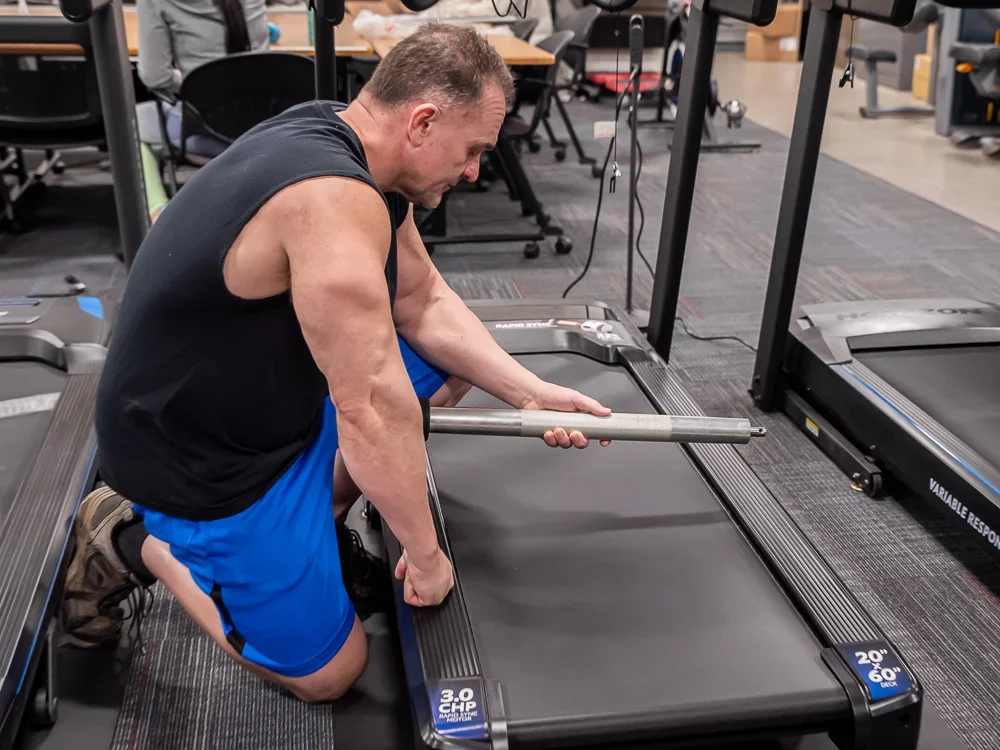
When shopping for treadmills, be sure to check out the roller and motor size if bodyweight is a concern.
What Goals Do You Have?
We’d guess that most people in the overweight to obese categories are looking to lose weight and a good treadmill can help. The good news for big people budget treadmills are indeed out there. Whether walking, running, or engaging in HIIT, treadmills offer a relatively low-impact means of caloric burn. More good news, the heavier one is, the more calories they burn by moving. Whereas the average 155-pound person burns 298 calories in 30 minutes running a 12-minute mile pace, a 300-pound individual can burn 1,300 doing the same activity.
When setting goals, consider the time frame in which they’re to be achieved. A 350-pound individual might want to lose 100 pounds, but doing this in a month is not only unrealistic, it can be unsafe. In addition to a medical professional’s advice, another great tool that can come in handy is an app designed for runners. We’ve reviewed some of the best online programming around here, and heavy people in particular might find these apps useful. For those unfamiliar with exercise, or perhaps in need of extra motivation, these programs not only monitor progress and heart rate, but often hook users into a dynamic network of friends via social media style communities.
Whether looking to lose a few pounds, or strengthen one’s cardiovascular system, treadmills are certainly a good choice to make. This is especially true for those which are foldable. But the longer the goal takes, the more important it is to consider a treadmill’s warranty and overall build quality. Cheaper doesn’t mean better when banging out the miles.
References
Ground Reaction Force Metrics Are Not Strongly Correlated With Tibial Bone Load When Running Across Speeds and Slopes: Implications for Science, Sport and Wearable Tech. Emily Matijevich, Lauren Branscombe, Leon Scott, Karl Zelik. PLOS ONE. Dec. 17, 2019. https://doi.org/10.1371.journal.pone.0210000.
Additional Treadmill Resources
Frequently Asked Questions
How much weight does the average treadmill hold?
Given the wide range of treadmills, from desk units to commercial, it's difficult to establish an average. That said, 250 pounds seems the norm.
What happens if you put too much weight on a treadmill?
Too much weight on a treadmill stresses the motor and belt. This can cause the motor to overheat and potentially burn out more quickly. The same is true of the belt, and depending on how much weight and time are involved, the frame could become damaged.
Is running bad for your knees if overweight?
We always recommend consulting with a medical professional for an individual assessment as every case is different. But if an overweight person has no history of knee pain, then jogging and walking are great ways to reduce that weight. It's important for one to know their limits and if joint pain is cause for concern, start out slow.
How long should an obese person treadmill?
As a rule, experts advise 45 to 60 minutes of exercise per day. But if obesity is an issue, then starting out with 10-minute sessions and working up in terms of resistance is good. If joint health is a concern, consider increasing the incline and speed of the 10-minute session as you go instead of trying to walk for longer periods.
Are treadmills better than walking outdoors?
We all love a good walk outdoors, but let's face it, Mother Nature can be unkind. The upside to a treadmill is you can walk any time of the year, day or night.
Is using a treadmill enough to lose weight?
While treadmills are a great tool for your weight loss strategy, there is no medical evidence to suggest they are the best solution for weight loss. Exercise on treadmills should be combined with other measures for optimal weight loss and management. Medical sources point to the importance of exercise every week: The CDC suggests 150 minutes a week of exercise. If a treadmill allows you to do that in your schedule, treadmills ca be a very effective tool. Source: https://www.cdc.gov/physicalactivity/basics/adults/index.htm
What are the weight capacities of each treadmill?
We have added the weight capacity of each pro and con of each treadmill we have tested.
What are some of the things to look for when researching treadmills for heavy people
Make sure you check for how robust the frame is, as that helps increase the stability and reduces stress on the machine during use. Also, check the strength of the motor: a higher horsepower motor is essential for handling the increased load of a heavier user.
Other Treadmill Reviews:
- Test HomePage
- NordicTrack Commercial X14i
- Echelon Stride
- NordicTrack C 590 Pro
- NordicTrack T 7.5 S - Pros & Cons (2024)
- Sole TD80 Treadmill Desk
- NordicTrack Commercial X11i
- NordicTrack T 8.5 S - Pros & Cons (2024)
- Horizon Elite T5
- Exerpeutic TF1000
- NordicTrack T 6.5 S - Pros & Cons (2024)
- ProForm Sport 5.0
- ProForm Premier 900
- ProForm ZT6
- NordicTrack FreeStride Trainer FS5i (Discontinued)
- Bowflex Max Trainer M5
- BowFlex TreadClimber TC100
- ProForm Power 795
- ProForm Sport 7.0
- NordicTrack Incline Trainer X15i
- NordicTrack C 1650 Treadmill
- Horizon Elite T9
- Official Boston Marathon Treadmill 4.0
- NordicTrack Treadmill Desk
- NordicTrack C 1630 Pro
- NordicTrack C 970 PRO
- Bowflex TC20 TreadClimber


